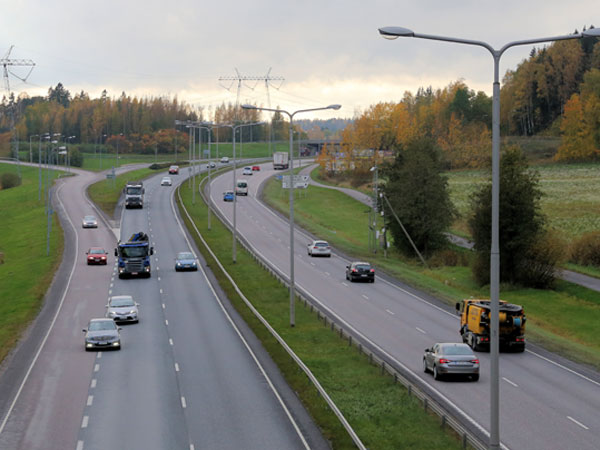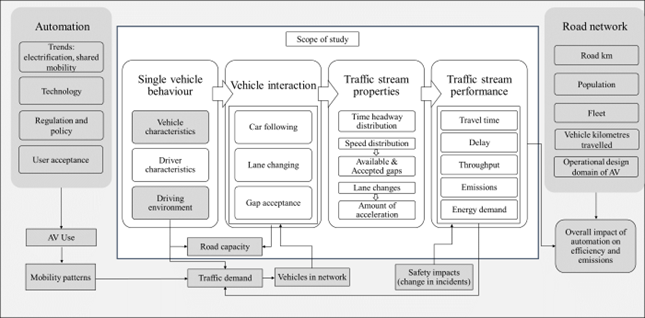Marketing and media have raised high expectations towards automated vehicles lowering road traffic emissions and improving efficiency, in addition to safety benefits. However, there is little evidence yet exists to support these claims, as found in a recent literature study.

With automated vehicles still being few on real roads, measuring their impacts on the traffic system is not yet possible. Rather, traffic simulations and field tests have been used. This paper studied what is known in current literature on the impacts of motorway driving automation without connectivity on traffic flow and emissions, reflecting on a conceptual framework of the four levels of traffic operations (Elefteriadou 2014): Single vehicle behaviour, vehicle interaction, traffic flow properties and traffic stream performance. Traffic flow properties and traffic stream performance are a result of characteristics and actions of single vehicle behaviour as well as vehicle interaction. Therefore, the assumptions made regarding driving characteristics, car following and lane changing behaviour greatly affect the traffic stream performance in terms of, for example, travel time and emissions.
A systematic literature review found that potential impacts of driving automation on efficiency and emissions have been estimated with simulation studies, field studies with single equipped vehicles in a naturalistic driving environment as well as controlled field tests with several commercial ACC (adaptive cruise control) equipped vehicles driving in a string. The focus has been on longitudinal vehicle motion control. Most studies to date have focused on impacts for the equipped vehicles, disregarding potential impacts for other road users, which are also affected by the changes in traffic dynamics, or for traffic as a whole.

While different study settings are suitable for assessing different factors affecting traffic flow efficiency and emissions, none is able to address all. The focus of simulation studies has mainly been on throughput and capacity, where benefits for traffic flow were found for systems with a desired time gap less than 1.2 s. Studies with single ACC vehicles focused on the driving behaviour of these vehicles, showing more stable car following and acceleration. Studies with strings of ACC vehicles mostly focused on string stability, finding that all tested commercial ACC controllers were string unstable, amplifying traffic perturbations and potentially causing traffic disruption. Thus, the theoretical controllers used in simulations, which can be optimised for traffic efficiency or emissions, seem to differ from those implemented in commercially available ACC systems, which appear to favour safety and comfort. While literature provides valuable insights within their respective contexts, their results cannot necessarily be interpreted as likely impacts of automation in the real world.
The study concludes that more comprehensive studies of potential impacts of driving automation are needed, and that results of published studies should be viewed within the context of their assumptions.
The research leading to these results has received funding from the European Commission Horizon 2020 program under the project L3Pilot, grant agreement number 723051. Responsibility for the information and views set out in this publication lies entirely with the author.
Text: Fanny Malin, VTT
Read more:
Aittoniemi, E.: Evidence on impacts of automated vehicles on traffic flow efficiency and emissions: Systematic review. IET Intell. Transp. Syst. 16, 1306– 1327 (2022).
Contact

Elina Aittoniemi
elina.aittoniemi@vtt.fi
VTT Technical Research Centre of Finland Ltd., Finland






Follow us: